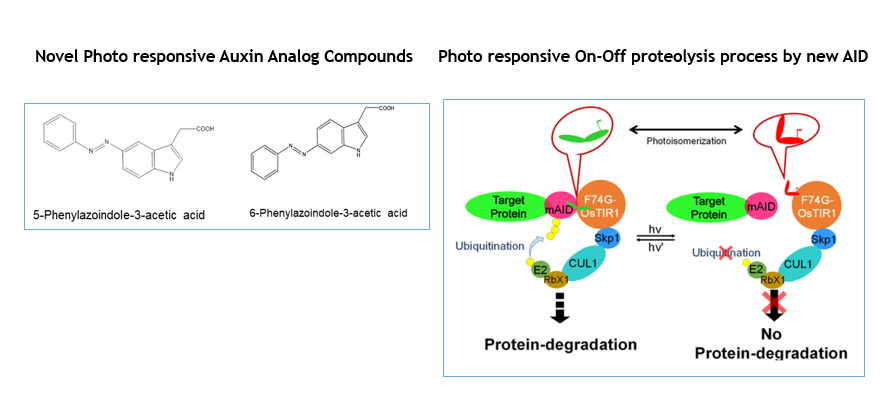Advantages
- AID kit with novel photo responsive auxin analogue
- Proteolysis can be observed only during continuous irradiation without repeated washing of buffer solution
- Allows light-irradiated position-selective proteolytic action
- Demonstrated degradation and accumulation of target proteins in human cell lines
Background & Technology
AID system is a protein degradation control technology, in which the plant-specific proteolysis system introduced by the plant hormone auxin is not used in eukaryotic cells of plant origin. The improved AID2 is also being developed, which enables precise targeted degradation to be induced with lower concentrations of inducing agents, making it possible to degrade proteins only in specific cells and tissues. On the other hand, the following issues remain in AID2.
(i) In the presence of many cells, it is difficult to specifically degrade only the target protein in a cell at a particular position.
(ii) In the presence of multiple cells, cells need to be washed out with buffer solution in order to observe the time series of target proteins, but this method does not allow continuous observation of the cell state and results in discontinuous observation.
This result is the invention of a new auxin analog whose steric structure is changed by light, and a new AID that can control proteolysis in a site-specific and time-specific manner.
 |
Data
Proteolysis demonstration by photo responsive auxine
A)Fluorescence microscopy of HAP1 cells co-expressing OsTIR1 (auxin receptor) and mAID-EGFP-NLS (protein-labeled degradation tag) before and after treatment with DMSO (control) and 5-phenylazoindole-3-acetic acid (1) at 10 nM for 4 hours, under dark and illuminated conditions proteolysis results. The results show that the addition of (1) can degrade intracellular GFP in a 365 nm light-dependent manner.
B)The left image shows GFP fluorescence observed by fluorescence microscopy in a group of cells partially irradiated with 150 nM of (1) and partially irradiated with 520 nm light as a background light and 365 nm light as a weak background light. The right image shows the same group of cells observed in bright field, showing that the cells are almost evenly distributed throughout the whole area.
 |
Publication
https://pubs.acs.org/doi/10.1021/jacs.4c05135?ref=PDF
Patent
・Pending
Researcher
Hokkaido University Research Institute for Electronic Science Professor Nobuyuki Tamaoki
Development Phase
Current stage: Demonstration of responsiveness and operability of photo response AIDs in human cells is complete.
Next stage:
1) Demonstration of applicable cells and versatility in accordance with intended use
2) Development of services and products, such as practical application processes and kits
3) Collaborative research based on the idea of developing this technology
We are looking for partner companies interested in introducing the technology or collaborating in the practical application/development of the above. We would be happy to start with a detailed explanation and discussion of the technology.
Project ID: ON-05230


